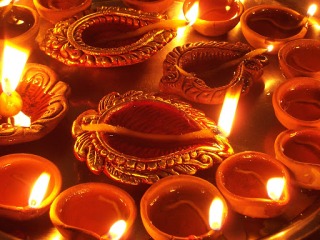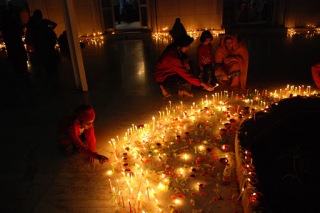Diwali: The Festival of Lights (For 2012, November 13-17)
 |
| Diwali diyas |
Each year, Myrtle and the Duke of Earl Grey and the rest of the gang go out of our way to celebrate Diwali (pronounced “dih-vah-lee”), the Indian festival of lights. It is the celebration of light, goodness and knowledge over darkness, evil and ignorance. And it is Queen Darling Darjeeling’s favourite time of year, the time we honour him, and the only time he is pleasant to his subjects. Also called “Deepawali,” the five-day celebration takes place in India, Pakistan, Sri Lanka and in other Indian and South Asian communities around the world. For a week each year in either October or November, according to the position of the Moon, the week of Diwali is a shared religious festival for Hindus, Sikhs and Jains. In Hinduism, it commemorates the New Year and the return of Lord Rama. Jains celebrate Lord Mahvira’s reaching of nirvana. For Sikhs, it marks the release from prison of the sixth guru, Guru Hargobind Ji. Even Buddhists recognise the festival and decorate their temples in honour of Diwali as the day Emperor Ashoka of India converted to Buddhism.
The celebration of Diwali takes on different expressions and traditions depending on country and region. Yet it usually involves the buying and wearing of new clothes, lighting diyas and filling the home and outside of the home with lights and colourful lanterns, gathering friends and families together for meals and prayers, giving and receiving gifts, sweets, nuts and cards, setting off fireworks, and decorating the home with colourful Rangoli designs for good luck.
In the Hindu religion, Diwali is the celebration of the New Year, a time to renew oneself, to begin a new year of business, to welcome good fortune, to clean one’s home and surroundings. It marks the end of the harvest and the celebrates the goddess Lakshmi and the god Ganesh. The third day of Diwali, the Lakshmi Puja, is considered the most important day, when the goddess is honoured in hope that she will bless one with wealth in the new year.
 |
| Swastika, a sacred Hindu symbol of blessings and good luck |
A Glossary of Diwali Words and Symbols
diya: an oil lamp usually made from clay, with a cotton wick dipped in ghee or vegetable oils. Also called a divaa, deepam or deepak.
puja (or pooja): a religious ritual performed by Hindus at home or at public temples based on the idea of giving a gift or offering to a deity or important person and receiving their blessing.
Lakshmi: in Hinduism, she is the goddess of wealth, prosperity (both material and spiritual), light, wisdom, fortune, fertility, generosity and courage. And she is the embodiment of beauty, grace and charm.
Ganesh: in Hinduism, the elephant-headed god who is widely revered as the Remover of Obstacles, Lord of Beginnings, Lord of Obstacles, patron of arts and sciences, and the god of intellect and wisdom, He is honoured at the beginning of rituals and ceremonies and invoked as Patron of Letters during writing sessions.
swastika: a Hindu sacred symbol of good luck that originated in Indus Valley civilisations. Later adopted for use by the Nazi party, which created its negative connotation.
thali: meaning “plate.” Western, Central, and North-Western Indian meal with contents varying from one regional to another. A thali is a selection of different dishes, usually served in small bowls on a round tray. The round tray is generally made with steel with multiple compartments. Typical dishes include rice, dhal, vegetables, roti, papad, curd (yoghurt), small amounts of chutney or pickle, and a sweet dish to top it off.
puja thali: a colourful plate of offerings decorated and offered to Lakshmi and Ganesh during Diwali.
rangoli: designs of colourful flour, sand or flowers made on floors of living rooms, in doorways, and in courtyards during Hindu festivals used to attract the good luck blessings of Lakshmi.
kandil: a colourful paper lantern
ghee: South Asian clarified butter, a is milk fat rendered from butter to separate the milk solids and water from the butterfat.
katli: an Indian sweet made from cashews, sugar, cardamom powder and pure-butter ghee. It is typically cut into rhombus shapes and covered with edible silver foil,
burfi (or barfi): an Indian sweet made from condensed milk, cooked with sugar.
A Diwali “Chai”
The celebration of Diwali is open to everyone who celebrates the triumph of good over evil and light over darkness, regardless of religion! To honour our great Queen Darling Darjeeling and his Indian culture, we have a week of Diwali tea parties, or “chai” parties we should say! Here’s how we celebrate the week of Diwali and ways you can, too!
1) Fill your house with diyas, electric Christmas lights, lanterns and all of the candles you own. Keep your house lit for the week in celebration of light, knowledge and goodness!
2) Invite friends and family over to cook your favourite Indian meals/curries and visit your favourite Indian restaurants! Or feel free to celebrate alone by taking yourself out for a lovely curry or thali! In London, many Indian restaurants have special Diwali menus!
3) Enjoy some “mithais,” or Indian sweets, for tea time. If you’ve never had Indian sweets before, Diwali is a great holiday to purchase some at your local Indian supermarket and try them. Darling Darjeeling’s favourites are gulab jamun, kaju katli, pista katli, pista burfi.
4) Give Diwali treats and gifts to your loved ones! Diwali cards, nuts, sweets, candles, and homemade bags of chai spices make excellent gifts during the festival.
5) Finally, talking of chai spices, celebrate the days of Diwali by drinking Darling Darjeeling’s famous masala chai recipe, which he is willing to share in celebration of the holiday!
 |
| His Majesty, Queen Darling Darjeeling of the Kingdom of Tcha |
DARLING DARJEELING’S MASALA CHAI
(Makes approximately 2 cups/500 ml)
Ingredients:
1 tsp loose black tea (preferably a strong, inexpensive brand like PG Tips or Yorkshire)
5 whole cardamom pods
5 whole cloves
5 peppercorns
Cinnamon stick
¼ tsp ginger, ground
⅓ cup (80 ml) whole milk (or to taste. I prefer evaporated milk for extra creaminess.)
1 ½ to 2 cups (400 to 500 ml) water (depending on desired strength of chai)
Demerara sugar or agave to sweeten
Instructions:
1) Combine water with all spices in a small saucepan and bring to a boil.
2) Immediately when the water boils, add the tea, milk, sugar and stir. Let the mixture come back to a boil and then immediately remove from heat. Do not boil the chai longer than 30 seconds, as water deoxidizes and can ruin the flavour of tea when over-boiled.
3) Pour into cup, separating the spices from the tea with a strainer. Enjoy!
 |
| At the Sikh Golden Temple in Amritsar, India |
 |
| Kandils |
Sources:
“Diwali.” Wikipedia, 2011.
“Lakshmi.” Wikipedia, 2011.
“Thali.” Wikipedia, 2011.










Leave a comment